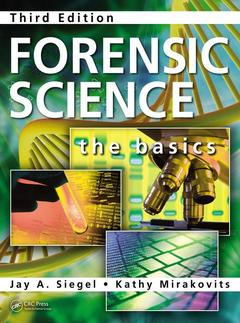Forensic Science (3rd Ed.) The Basics, Third Edition
Auteurs : Lee Elsa, Mirakovits Kathy

This new edition of Forensic Science: The Basics provides a fundamental background in forensic science as well as criminal investigation and court testimony. It describes how various forms of data are collected, preserved, and analyzed, and also explains how expert testimony based on the analysis of forensic evidence is presented in court.
The book addresses knowledge of the natural and physical sciences while introducing readers to the application of science to the justice system. Each chapter begins by presenting a set of learning objectives, a mini glossary, and acronyms. The book is also structured so that each chapter can stand on its own, allowing for continuous or selected reading and study.
The Third Edition includes:
- Fully updated chapters to reflect current best practices
- Three new chapters on use of detector dogs in forensic science, forensic engineering, and digital evidence and computer forensics
- Case studies throughout that apply concepts to real-world examples
The third edition of Forensic Science: The Basics is an ideal starting point for students with a basic science background but no experience in forensic science. It reinforces basic science knowledge while presenting the foundational aspects of forensic science theory and practice.
FORENSIC SCIENCE AND INVESTIGATION. Introduction to Forensic Science. Crime Scene Investigation. Nature of Evidence. TOOLS OF THE TRADE.Separating Complex Mixtures. Light and Matter. Microscopy. Detector Dogs as Forensic Tools. Digital Evidence, Computer Forensics, and Investigation. Forensic Engineering. PATTERNS AND IMPRESSIONS. Fingerprints and Other Impressions. Questioned Documents. Firearms and Toolmarks. FORENSIC BIOLOGY. Forensic Pathology. Anthropology and Odontology. Forensic Entomology. Serology. DNA Typing. Hair. FORENSIC CHEMISTRY. Illicit Drugs. Forensic Toxicology. Fibers, Paints, and Other Polymers. Glass and Soil. Fires and Explosions. LEGAL ASPECTS OF FORENSIC SCIENCE. Presentation of Forensic Evidence in Court.
Jay A. Siegel holds a PhD in analytical chemistry from The George Washington University and received its Distinguished Faculty Scholar award in 2009. He worked as a forensic chemist with the Virginia Bureau of Forensic Sciences for three years before spending 25 years as a professor and director of the forensic science program in the School of Criminal Justice at Michigan State University. In 2003 he went to Indiana University–Purdue University as founder and director of the forensic and investigative sciences program in the School of Science. In 2008 he was named the chair of the Department of Chemistry and Chemical Biology. He retired in 2012. Dr. Siegel is the co-editor of Forensic Science Policy and Management: An International Journal and Encyclopedia of Forensic Sciences, Second Edition, the co-author of Fundamentals of Forensic Science, and the author of Forensic Science: A Beginner’s Guide. He has testified over 200 times in federal and military courts, and was named distinguished fellow of the American Academy of Forensic Sciences in 2009.
Kathy Mirakovits teaches forensic science and physics at Portage Northern High School in Portage, Michigan, and physics at Kalamazoo Valley Community College in Michigan. She holds an MS in science education from Western Michigan University. She has taught general science, physical science, chemistry, biology, earth science, and physics at the high school and two-year college level for 25 years. She also conducts workshops across the United States for teachers who wish to learn the application of forensic science in a school curriculum. She has developed numerous forensic science educational products and has led workshops at the National Science Teachers Association. Kathy has served as president of the Michigan Chapter of the American Association of Physics Teachers and as a curriculum writer for the Michigan Department of Education. She is currently the high school
Date de parution : 12-2015
21x28 cm
Disponible chez l'éditeur (délai d'approvisionnement : 13 jours).
Prix indicatif 133,46 €
Ajouter au panierThèmes de Forensic Science :
Mots-clés :
Forensic Odontology; Crime Scene Investigation; National Academy; forensic dna profiling; DNA Typing; forensic biology; Forensic Anthropology; forensic DNA; Footwear Impression Evidence; DNA analysis; GSR; forensic genetics; Crime Scene; forensic science; Forensic Science; forensic investigations; Crime Scene Investigator; crime scene; Footwear Impression; crime scene evidence; Friction Ridges; human remains; Forensic Engineers; DNA sampling; Forensic Science Laboratory; forensic scientist; Medicolegal Autopsies; forensi



